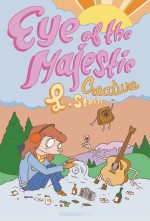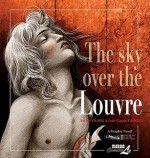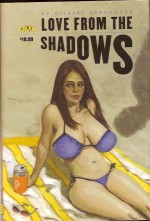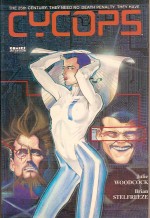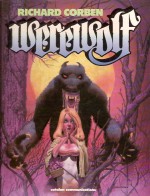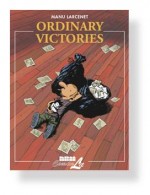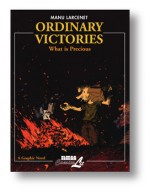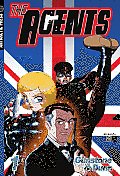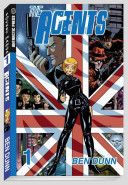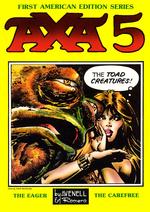
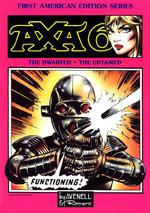
By Donne Avenell & Enrique Badia Romero (Ken Pierce Books)
Vol. 5 ISBN: 0-912277-21-1Â Â Vol. 6 no ISBN: 0-912277-22-X
Although the “Swinging Sixties†is thought of as the moment when we all lost our prudish innocence, the real era of sexual liberation was the early 1970s. In that period of swiftly shifting social and cultural morés and rapidly evolving attitudes to adult behaviour British newspapers radically altered much of their traditional style and content in response to the seemingly inexorable wave of female social emancipation and reputed sexual equality.
All the same, this still allowed newspaper editors plenty of leeway to squeeze in oodles of undraped women, who finally escaped from the perfectly rendered comics strips and onto the regular pages (usually the third one), the centre-spreads, pop pages and fashion features…
However the only place where truly affirmative female role-models appeared to be taken seriously were the aforementioned cartoon sections, but even there the likes of Modesty Blaise, Danielle, Scarth, Amanda and all the other capable ladies who walked all over the oppressor gender, both humorously and in straight adventure scenarios, lost clothes and shed undies repeatedly, continuously, frivolously and in the manner they always had…
Nobody complained (no one important or who was ever taken seriously): it was just tradition and the idiom of the medium… and besides, most artists have always liked to draw bare-naked ladies as much as blokes liked to see them and it was even educational for the kiddies – who could buy any newspaper in any shop without interference even if they couldn’t get into cinemas to view Flashdance, Trading Places or Spacehunter: Adventures in the Forbidden Zone without an accompanying adult…
Sales kept soaring…
Take-charge chicks were practically commonplace when the Star Wars phenomenon reinvigorated public interest in science fiction and the old standby of scantily-clad, curvy amazons and post-apocalyptic wonderlands regained their sales-appeal. Thus The Sun hired Enrique Badia Romero and Donne Avenell to produce just such an attention-getter for their already well-stacked cartoon section.
Romero had begun his career in Spain in 1953, producing everything from westerns, sports, war stories and trading cards, often in conjunction with his brother Jorge BadÃa Romero. He even formed his own publishing house. “Enric†began working for the higher-paying UK market in the 1960s on strips such as ‘Cathy and Wendy’, ‘Isometrics’ and ‘Cassius Clay’ before successfully assuming the drawing duties on the high-profile Modesty Blaise strip in 1970 (see Modesty Blaise: The Hell Makers and Modesty Blaise: The Green Eyed Monster), only leaving when this enticing new prospect appeared.
In 1986 political and editorial intrigue saw Axa cancelled in the middle of a story and Romero returned to the bodacious Blaise until creator/writer Peter O’Donnell retired in 2001. Since then he has produced Modesty material for Scandinavia and a number of projects such as Durham Red for 2000AD.
Axa ran in The Sun Monday to Saturday from 1978 to her abrupt disappearance in 1986 and, other than these slim volumes from strip historian Ken Pierce, has never been graced with a definitive collection. It should be noted also that at the time of these books the strip was still being published to great acclaim.
In ‘Axa the Eager’ opens with the winsome wanderer and her current paramour Dirk drifting along barren coastlines until they encounter a bird-like man-creature and are drawn inescapably into a clash of ideologies between two factions of tree-dwelling humanoids.
One, led by the boisterous dreamer Zeph, wishes to remain in the safety of the canopies until they evolve into true fliers whilst his brother Galen wishes to return the Sky People to the Earth and the ways of technological progress. The division also splits Dirk and Axa and to complicate matters further the solid ground they’re all squawking about is surrounded by deadly mutated toad monsters…
Powerful and impressively philosophical, this tale of family discord could only end in tragedy…
‘Axa the Carefree’ finds the chastened explorers travelling inland to a new and desolate landscape concealing a sedate well-hidden village. Impossibly it seems to have escaped unscathed the horrors of the Great Contamination and investigating further Axa and Dirk discover a population of simple peasants blithely thriving, unaware of the horrors of the last hundred years. However, as always, things are not as they seem and the farmers are only a satellite branch of specialist technological guilds collectively dubbed “The Artisansâ€.
Ever curious the nubile nomad sneaks into the mountain citadel of the Artisans to find a virtual paradise where her wild beauty captivates one too many of the masters of the Craft Guilds that run the place. She is also reunited with her lost companion Mark 10, a robotic servant she won and lost in Axa volume 3.
Tensions are already rising when the bored and enamoured Galen stumbles onto the scene and, as her very presence incites the normally-stable creative types into a kind of madness, there looks to be a revolution in the Artisans’ immediate future unless Axa can broker a return to productive rationality…
Axa 6 dispenses with tedious text and dashes straight into the graphic action of ‘Axa the Dwarfed’ with the glorious gladiatrix and Mark 10 abandoning the Artisans to trek across a bleak wasteland until they stumble into an old government research facility where the flora and insect life has grown to immense proportions. Moreover, truly advanced and properly civilised scientists appear to be running the whole show…
Typically however, even this technological Garden of Eden has a serpent in the form of one boffin with a little too much ambition, so it’s a lucky thing old flame Matt has been tracking Axa for months and finally reunites with her just as the unscrupulous mastermind makes his move…
‘Axa the Untamed’ finds the fiery fury dragging Matt and Mark 10 into a different kind of danger when the trio encounter a tribe of Gipsies who have proliferated into a modern horde of nomadic Mongol plainsmen, trading horses and other valuable commodities in a mad, macho wonderland of testosterone and arrogance.
Even Axa’s freedom-fuelled head is turned by the attentions of Gipsy Prince Django, much to Matt’s dismay, but it isn’t too long before the glamour fades and the worth of women in Django’s world leads her to reassess its value. It’s a lot harder to cure her love affair with his magnificent horses though…
These tales are superb examples of the uniquely British newspaper strip style: lavishly drawn, subversively written, expansive in scope and utterly enchanting in their basic simplicity – with lots of flashed flesh, emphatic action and sly, knowing humour. Eminently readable and re-readable (and there’s still that dwindling promise of a major motion picture) Axa is long overdue for a definitive collection. Here’s hoping there’s a bold publisher out there looking for the next big thing…
© 1984 Express Newspapers, Ltd.
